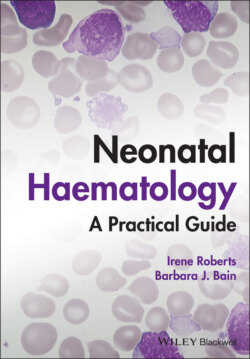Читать книгу Neonatal Haematology - Barbara J. Bain, Irene Roberts - Страница 29
Neutrophils
ОглавлениеAt birth, neutrophils are the most plentiful of the circulating leucocytes in healthy neonates, constituting 50–60% of the total circulating white cells, in both term and preterm infants.64,65,67 The absolute neutrophil count at birth is slightly higher in preterm neonates (averaging about 15 × 109/l) than in term neonates (averaging about 10 × 109/l),64 and in most preterm neonates (<28 weeks’ gestation at birth), the peripheral blood also often contains neutrophil precursors (metamyelocytes, myelocytes and promyelocytes) in small numbers, even when the baby is well (Fig. 1.15).
Neutrophils are produced almost entirely in the bone marrow during fetal life.16 The numbers of circulating neutrophils in fetal blood samples taken in the first and second trimester are low (0.1–0.2 × 109/l),94 most likely because so much of the bone marrow at this gestation is devoted to expanding B cell production.8 Thereafter, as granulopoiesis is established in the fetal bone marrow, the numbers of neutrophils gradually rise to reach over 2 × 109/l at the end of the third trimester. Nevertheless, the absolute neutrophil mass per kilogram is less than 25% of adult values in term neonates and slightly lower (20% of adult values) in preterm neonates.95 This means that reserves of mature neutrophils in the bone marrow (sometimes referred to as the neutrophil storage pool) are rapidly depleted in neonates. This explains the frequent occurrence of severe neutropenia in preterm neonates as an immediate response to acute bacterial infection or necrotising enterocolitis (NEC) (Fig. 1.16) (see Chapter 3).98–100 In contrast, adults have large reserves of neutrophils and neutrophil progenitors in the bone marrow, which can be rapidly recruited to boost neutrophil numbers in response to sepsis.
Fig. 1.15 Blood film of a well preterm neonate showing a myelocyte and three normal neutrophils. MGG, ×100.
Fig. 1.16 Blood film of a preterm neonate with early clinical signs of necrotising enterocolitis showing severe neutropenia and moderate thrombocytopenia. Note the cytoplasmic vacuolation in the single neutrophil and the presence of large platelets and some schistocytes suggestive of disseminated intravascular coagulation (DIC). MGG, ×40.
Normal ranges for neutrophil counts in neonates were updated by Schmutz et al. in 2008.64 These vary by gestational age at birth (see Table 1.2) and also by postnatal age, particularly over the first 24 hours. In healthy term babies the neutrophil count peaks at around 15.0 × 109/l (range 7.5–28.5 × 109/l) 6–12 hours after birth, with a very similar pattern also seen in healthy preterm babies over 28 weeks’ gestation.64 Normal ranges for very low birthweight neonates less than 28 weeks’ gestation are difficult to establish because of the high frequency of medical problems, including infection, in these babies. In practice, the main clinical value of neutrophil normal ranges is to identify neonates with clinically significant neutropenia, especially those with severe congenital neutropenia (SCN), where prompt diagnosis is essential to prevent life‐threatening complications. In SCN, the neutrophil count will nearly always be persistently low, although transient and moderate rises sometimes occur in the setting of infection. As a result, serial neutrophil measurements, as well as assessment of a blood film, are essential to rule out acquired disorders associated with neutropenia persisting for more than a week, for example cytomegalovirus (CMV) infection.
